Virtual Power Plant Optimization in Smart Grids: A Narrative Review
Abstract
:1. Introduction
2. Materials and Methods
- Searching strategy: database, search key words/key phrases;
- The main inclusion/exclusion criteria: types of articles, language, time periods, visibility, and availability.
3. VPP Concept and Technology
3.1. Digital Twins’ Models
3.2. Energy Forecasting
3.3. Optimization and Coordination
4. VPP Applications in Smart Grids
- VPP coordinates energy resources for collectively providing energy services in different markets or directly to interested stakeholders such as a DSO;
- VPP coordinates energy resources for local energy autonomy to achieve an optimal balance between the demand and supply and to minimize energy exchanges among microgrids and the main grid;
- VPP coordinates energy resources for the optimal implementation of sustainable energy communities considering in addition to energy aspects the local economic and social factors.
4.1. Energy Services Delivery
4.2. Local Energy Autonomy
4.3. Energy Communities’ Sustainability
5. Discussion
6. Conclusions
Author Contributions
Funding
Data Availability Statement
Acknowledgments
Conflicts of Interest
References
- Talari, S.; Shafie-Khah, M.; Osório, G.J.; Aghaei, J.; Catalão, J.P.S. Stochastic modelling of renewable energy sources from operators’ point-of-view: A survey. Renew. Sustain. Energy Rev. 2018, 81, 1953–1965. [Google Scholar] [CrossRef]
- Escobar, J.J.M.; Matamoros, O.M.; Padilla, R.T.; Reyes, I.L.; Espinosa, H.Q. A Comprehensive Review on Smart Grids: Challenges and Opportunities. Sensors 2021, 21, 6978. [Google Scholar] [CrossRef] [PubMed]
- Naval, N.; Yusta, J.M. Virtual power plant models and electricity markets—A review. Renew. Sustain. Energy Rev. 2021, 149, 111393. [Google Scholar] [CrossRef]
- Oest, F.; Radtke, M.; Blank-Babazadeh, M.; Holly, S.; Lehnhoff, S. Evaluation of Communication Infrastructures for Distributed Optimization of Virtual Power Plant Schedules. Energies 2021, 14, 1226. [Google Scholar] [CrossRef]
- Sarmiento-Vintimilla, J.C.; Torres, E.; Larruskain, D.M.; Pérez-Molina, M.J. Applications, Operational Architectures and Development of Virtual Power Plants as a Strategy to Facilitate the Integration of Distributed Energy Resources. Energies 2022, 15, 775. [Google Scholar] [CrossRef]
- Bhuiyan, E.A.; Hossain, Z.; Muyeen, S.; Fahim, S.R.; Sarker, S.K.; Das, S.K. Towards next generation virtual power plant: Technology review and frameworks. Renew. Sustain. Energy Rev. 2021, 150, 111358. [Google Scholar] [CrossRef]
- Ferrari, R. Writing narrative style literature reviews. Med Writ. 2015, 24, 230–235. [Google Scholar] [CrossRef]
- Green, B.N.; Johnson, C.D.; Adams, A. Writing narrative literature reviews for peer-reviewed journals: Secrets of the trade. J. Chiropr. Med. 2006, 5, 101–117. [Google Scholar] [CrossRef] [Green Version]
- Onile, A.E.; Machlev, R.; Petlenkov, E.; Levron, Y.; Belikov, J. Uses of the digital twins concept for energy services, intelligent recommendation systems, and demand side management: A review. Energy Rep. 2021, 7, 997–1015. [Google Scholar] [CrossRef]
- Sleiti, A.K.; Kapat, J.S.; Vesely, L. Digital twin in energy industry: Proposed robust digital twin for power plant and other complex capital-intensive large engineering systems. Energy Rep. 2022, 8, 3704–3726. [Google Scholar] [CrossRef]
- Borowski, P. Digitization, Digital Twins, Blockchain, and Industry 4.0 as Elements of Management Process in Enterprises in the Energy Sector. Energies 2021, 14, 1885. [Google Scholar] [CrossRef]
- Fuller, A.; Fan, Z.; Day, C.; Barlow, C. Digital Twin: Enabling Technologies, Challenges and Open Research. IEEE Access 2020, 8, 108952–108971. [Google Scholar] [CrossRef]
- Wu, Y.; Zhang, K.; Zhang, Y. Digital Twin Networks: A Survey. IEEE Internet Things J. 2021, 8, 13789–13804. [Google Scholar] [CrossRef]
- Kaewunruen, S.; Rungskunroch, P.; Welsh, J. A Digital-Twin Evaluation of Net Zero Energy Building for Existing Buildings. Sustainability 2018, 11, 159. [Google Scholar] [CrossRef] [Green Version]
- Clausen, A.; Arendt, K.; Johansen, A.; Sangogboye, F.C.; Kjærgaard, M.B.; Veje, C.T.; Jørgensen, B.N. A digital twin framework for improving energy efficiency and occupant comfort in public and commercial buildings. Energy Inform. 2021, 4, 1–19. [Google Scholar] [CrossRef]
- Bazmohammadi, N.; Madary, A.; Vasquez, J.C.; Mohammadi, H.B.; Khan, B.; Wu, Y.; Guerrero, J.M. Microgrid Digital Twins: Concepts, Applications, and Future Trends. IEEE Access 2021, 10, 2284–2302. [Google Scholar] [CrossRef]
- Fathy, Y.; Jaber, M.; Nadeem, Z. Digital Twin-Driven Decision Making and Planning for Energy Consumption. J. Sens. Actuator Networks 2021, 10, 37. [Google Scholar] [CrossRef]
- Xu, B.; Wang, J.; Wang, X.; Liang, Z.; Cui, L.; Liu, X.; Ku, A.Y. A case study of digital-twin-modelling analysis on power-plant-performance optimizations. Clean Energy 2019, 3, 227–234. [Google Scholar] [CrossRef] [Green Version]
- Park, H.-A.; Byeon, G.; Son, W.; Jo, H.-C.; Kim, J.; Kim, S. Digital Twin for Operation of Microgrid: Optimal Scheduling in Virtual Space of Digital Twin. Energies 2020, 13, 5504. [Google Scholar] [CrossRef]
- Abideen, A.Z.; Sundram, V.P.K.; Pyeman, J.; Othman, A.K.; Sorooshian, S. Digital Twin Integrated Reinforced Learning in Supply Chain and Logistics. Logistics 2021, 5, 84. [Google Scholar] [CrossRef]
- Abdeen, F.N.; Sepasgozar, S.M.E. City Digital Twin Concepts: A Vision for Community Participation. Environ. Sci. Proc. 2022, 12, 19. [Google Scholar] [CrossRef]
- Duc, H.N.; Hong, N.N. Optimal Reserve and Energy Scheduling for a Virtual Power Plant Considering Reserve Activation Probability. Appl. Sci. 2021, 11, 9717. [Google Scholar] [CrossRef]
- Khan, P.W.; Kim, Y.; Byun, Y.-C.; Lee, S.-J. Influencing Factors Evaluation of Machine Learning-Based Energy Consumption Prediction. Energies 2021, 14, 7167. [Google Scholar] [CrossRef]
- Abdelaziz, A.; Santos, V.; Dias, M.S. Machine Learning Techniques in the Energy Consumption of Buildings: A Systematic Literature Review Using Text Mining and Bibliometric Analysis. Energies 2021, 14, 7810. [Google Scholar] [CrossRef]
- Vesa, A.V.; Cioara, T.; Anghel, I.; Antal, C.; Pop, C.; Iancu, B.; Salomie, I.; Dadarlat, V.T. Energy Flexibility Prediction for Data Center Engagement in Demand Response Programs. Sustainability 2020, 12, 1417. [Google Scholar] [CrossRef] [Green Version]
- Mustaqeem; Ishaq, M.; Kwon, S. Short-Term Energy Forecasting Framework Using an Ensemble Deep Learning Approach. IEEE Access 2021, 9, 94262–94271. [Google Scholar] [CrossRef]
- Da Silva, D.G.; Geller, M.T.B.; dos Santos Moura, M.S. Anderson Alvarenga de Moura Meneses, Performance Evaluation of LSTM Neural Networks for Consumption Prediction. E Prime Adv. Electr. Eng. Electron. Energy 2022, 2, 100030. [Google Scholar]
- Agga, A.; Abbou, A.; Labbadi, M.; El Houm, Y.; Ali, I.H.O. CNN-LSTM: An efficient hybrid deep learning architecture for predicting short-term photovoltaic power production. Electr. Power Syst. Res. 2022, 208, 107908. [Google Scholar] [CrossRef]
- Saeed, F.; Paul, A.; Seo, H. A Hybrid Channel-Communication-Enabled CNN-LSTM Model for Electricity Load Forecasting. Energies 2022, 15, 2263. [Google Scholar] [CrossRef]
- Tovar, M.; Robles, M.; Rashid, F. PV Power Prediction, Using CNN-LSTM Hybrid Neural Network Model. Case of Study: Temixco-Morelos, México. Energies 2020, 13, 6512. [Google Scholar] [CrossRef]
- Shachee, S.B.; Latha, H.N.; Hegde Veena, N. Electrical Energy Consumption Prediction Using LSTM-RNN. In Evolutionary Computing and Mobile Sustainable Networks. Lecture Notes on Data Engineering and Communications Technologies; Suma, V., Fernando, X., Du, K.L., Wang, H., Eds.; Springer: Singapore, 2022; Volume 116. [Google Scholar]
- Burg, L.; Gürses-Tran, G.; Madlener, R.; Monti, A. Comparative Analysis of Load Forecasting Models for Varying Time Horizons and Load Aggregation Levels. Energies 2021, 14, 7128. [Google Scholar] [CrossRef]
- Hong, T.; Pinson, P.; Wang, Y.; Weron, R.; Yang, D.; Zareipour, H. Energy Forecasting: A Review and Outlook. IEEE Open Access J. Power Energy 2020, 7, 376–388. [Google Scholar] [CrossRef]
- Xu, P.-F.; Han, C.-B.; Cheng, H.-X.; Cheng, C.; Ge, T. A Physics-Informed Neural Network for the Prediction of Unmanned Surface Vehicle Dynamics. J. Mar. Sci. Eng. 2022, 10, 148. [Google Scholar] [CrossRef]
- Hooshmand, R.-A.; Nosratabadi, S.M.; Gholipour, E. Event-based scheduling of industrial technical virtual power plant considering wind and market prices stochastic behaviors—A case study in Iran. J. Clean. Prod. 2018, 172, 1748–1764. [Google Scholar] [CrossRef]
- Kasaei, M.J.; Gandomkar, M.; Nikoukar, J. Optimal management of renewable energy sources by virtual power plant. Renew. Energy 2017, 114, 1180–1188. [Google Scholar] [CrossRef]
- Sharma, H.; Mishra, S.; Dhillon, J.; Sharma, N.K.; Bajaj, M.; Tariq, R.; Rehman, A.U.; Shafiq, M.; Hamam, H. Feasibility of Solar Grid-Based Industrial Virtual Power Plant for Optimal Energy Scheduling: A Case of Indian Power Sector. Energies 2022, 15, 752. [Google Scholar] [CrossRef]
- Taheri, S.I.; Salles, M.B.C.; Costa, E.C.M. Optimal Cost Management of Distributed Generation Units and Microgrids for Virtual Power Plant Scheduling. IEEE Access 2020, 8, 208449–208461. [Google Scholar] [CrossRef]
- Shabanzadeh, M.; Eslami, M.; Haghifam, M.-R. An interactive cooperation model for neighboring virtual power plants. Appl. Energy 2017, 200, 273–289. [Google Scholar] [CrossRef]
- Zamani, A.G.; Zakariazadeh, A.; Jadid, S. Day-ahead resource scheduling of a renewable energy based virtual power plant. Appl. Energy 2016, 169, 324–340. [Google Scholar] [CrossRef]
- Duan, J.; Wang, X.; Gao, Y.; Yang, Y.; Yang, W.; Li, H.; Ehsan, A. Multi-Objective Virtual Power Plant Construction Model Based on Decision Area Division. Appl. Sci. 2018, 8, 1484. [Google Scholar] [CrossRef] [Green Version]
- Rädle, S.; Mast, J.; Gerlach, J.; Bringmann, O. Computational intelligence based optimization of hierarchical virtual power plants. Energy Syst. 2021, 12, 517–544. [Google Scholar] [CrossRef] [Green Version]
- Howell, S.; Rezgui, Y.; Hippolyte, J.-L.; Jayan, B.; Li, H. Towards the next generation of smart grids: Semantic and holonic multi-agent management of distributed energy resources. Renew. Sustain. Energy Rev. 2017, 77, 193–214. [Google Scholar] [CrossRef]
- Naughton, J.; Wang, H.; Riaz, S.; Cantoni, M.; Mancarella, P. Optimization of multi-energy virtual power plants for providing multiple market and local network services. Electr. Power Syst. Res. 2020, 189, 106775. [Google Scholar] [CrossRef]
- Zhang, M.; Xu, Q.; Zhang, C.; Blaabjerg, F. Decentralized Coordination and Stabilization of Hybrid Energy Storage Systems in DC Microgrids. IEEE Trans. Smart Grid 2022, 1. [Google Scholar] [CrossRef]
- Shabanzadeh, M.; Sheikh-El-Eslami, M.K.; Haghifam, M.-R. A medium-term coalition-forming model of heterogeneous DERs for a commercial virtual power plant. Appl. Energy 2016, 169, 663–681. [Google Scholar] [CrossRef]
- Dib, M.; Abdallah, R.; Dib, O. Optimization Approach for the Aggregation of Flexible Consumers. Electronics 2022, 11, 628. [Google Scholar] [CrossRef]
- Feng, C.; Wang, Y.; Chen, Q.; Ding, Y.; Strbac, G.; Kang, C. Smart grid encounters edge computing: Opportunities and applications. Adv. Appl. Energy 2020, 1, 100006. [Google Scholar] [CrossRef]
- Kunal, S.; Saha, A.; Amin, R. An overview of cloud-fog computing: Architectures, applications with security challenges. Secur. Priv. 2019, 2, e72. [Google Scholar] [CrossRef]
- Perera, C.; Qin, Y.; Estrella, J.C.; Reiff-Marganiec, S.; Vasilakos, A.V. Fog computing for sustainable smart cities: A survey. ACM Comput. Surv. 2017, 50, 32. [Google Scholar] [CrossRef] [Green Version]
- Gligor, A.; Cofta, P.; Marciniak, T.; Dumitru, C.-D. Challenges for the Large-Scale Integration of Distributed Renewable Energy Resources in the Next Generation Virtual Power Plants. Proceedings 2020, 63, 20. [Google Scholar] [CrossRef]
- Trivedi, R.; Patra, S.; Sidqi, Y.; Bowler, B.; Zimmermann, F.; Deconinck, G.; Papaemmanouil, A.; Khadem, S. Community-Based Microgrids: Literature Review and Pathways to Decarbonise the Local Electricity Network. Energies 2022, 15, 918. [Google Scholar] [CrossRef]
- Sikorski, T.; Jasiński, M.; Ropuszyńska-Surma, E.; Węglarz, M.; Kaczorowska, D.; Kostyla, P.; Leonowicz, Z.; Lis, R.; Rezmer, J.; Rojewski, W.; et al. A Case Study on Distributed Energy Resources and Energy-Storage Systems in a Virtual Power Plant Concept. Tech. Aspects. Energ. 2020, 13, 3086. [Google Scholar] [CrossRef]
- Zamani, A.G.; Zakariazadeh, A.; Jadid, S.; Kazemi, A. Stochastic operational scheduling of distributed energy resources in a large scale virtual power plant. Int. J. Electr. Power Energy Syst. 2016, 82, 608–620. [Google Scholar] [CrossRef]
- Popławski, T.; Dudzik, S.; Szeląg, P.; Baran, J. A Case Study of a Virtual Power Plant (VPP) as a Data Acquisition Tool for PV Energy Forecasting. Energies 2021, 14, 6200. [Google Scholar] [CrossRef]
- Naughton, J.; Cantoni, M.; Mancarella, P. A Modelling Framework for a Virtual Power Plant with Multiple Energy Vectors Providing Multiple Services. In Proceedings of the 2019 IEEE Milan PowerTech, Milan, Italy, 23–27 June 2019; pp. 1–6. [Google Scholar]
- Liang, Z.; Alsafasfeh, Q.; Jin, T.; Pourbabak, H.; Su, W. Risk-Constrained Optimal Energy Management for Virtual Power Plants Considering Correlated Demand Response. IEEE Trans. Smart Grid 2017, 10, 1577–1587. [Google Scholar] [CrossRef]
- Naina, P.M.; Rajamani, H.-S.; Swarup, K.S. Modeling and simulation of virtual power plant in energy management system applications. In Proceedings of the 2017 7th International Conference on Power Systems (ICPS), Shivajinagar, India, 21–23 December 2017; pp. 392–397. [Google Scholar]
- Zhou, Y.; Wei, Z.; Sun, G.; Cheung, K.W.; Zang, H.; Chen, S. Four-level robust model for a virtual power plant in energy and reserve markets. IET Gener. Transm. Distrib. 2019, 13, 2036–2043. [Google Scholar] [CrossRef]
- Sheidaei, F.; Ahmarinejad, A. Multi-stage stochastic framework for energy management of virtual power plants considering electric vehicles and demand response programs. Int. J. Electr. Power Energy Syst. 2020, 120, 106047. [Google Scholar] [CrossRef]
- Cioara, T.; Antal, M.; Mihailescu, V.T.; Antal, C.D.; Anghel, I.M.; Mitrea, D. Blockchain-Based Decentralized Virtual Power Plants of Small Prosumers. IEEE Access 2021, 9, 29490–29504. [Google Scholar] [CrossRef]
- Pop, C.; Antal, M.; Cioara, T.; Anghel, I.; Salomie, I.; Bertoncini, M. Pop A Fog Computing enabled Virtual Power Plant Model for Delivery of Frequency Restoration Reserve Services. Sensors 2019, 19, 4688. [Google Scholar] [CrossRef] [Green Version]
- Candra, D.I.; Hartmann, K.; Nelles, M. Economic Optimal Implementation of Virtual Power Plants in the German Power Market. Energies 2018, 11, 2365. [Google Scholar] [CrossRef]
- Raveduto, G.; Croce, V.; Antal, M.; Pop, C.; Anghel, I.; Cioara, T. Dynamic Coalitions of Prosumers in Virtual Power Plants for Energy Trading and Profit Optimization. In Proceedings of the 2020 IEEE 20th Mediterranean Electrotechnical Conference, Palermo, Italy, 16–18 June 2020. [Google Scholar]
- H2020 eDREAM, Deliverable D3.3-Consumption Flexibility Models and Aggregation Techniques. Available online: https://edream-h2020.eu/wp-content/uploads/2019/07/eDREAM.D3.3.TUC_.WP3_.V1.0-compressed.pdf (accessed on 19 April 2022).
- Toshiba VPP. Available online: https://www.toshiba-energy.com/en/renewable-energy/product/vpp.htm (accessed on 19 April 2022).
- Toshiba Trial. Available online: https://www.global.toshiba/ww/news/corporate/2016/07/pr0601.html (accessed on 19 April 2022).
- NEMOCS VPP. Available online: https://www.next-kraftwerke.com/products/vpp-solution (accessed on 19 April 2022).
- Tesla VPP. Available online: https://www.tesla.com/support/energy/powerwall/own/california-virtual-power-plant (accessed on 19 April 2022).
- Sonnen VPP. Available online: https://www.globenewswire.com/news-release/2021/07/14/2262872/0/en/sonnen-Partners-with-Sustainable-Westchester-to-Launch-sonnenCommunity-New-York-a-Virtual-Power-Plant-Operating-in-the-NYISO-Market.html (accessed on 19 April 2022).
- Swell VPP. Available online: https://www.swellenergy.com/ (accessed on 19 April 2022).
- Battery Energy VPP. Available online: https://www.greentechmedia.com/articles/read/10-victories-for-virtual-power-plants-in-2020 (accessed on 19 April 2022).
- Park, S.-W.; Son, S.-Y. Interaction-based virtual power plant operation methodology for distribution system operator’s voltage management. Appl. Energy 2020, 271, 115222. [Google Scholar] [CrossRef]
- Pasetti, M.; Rinaldi, S.; Manerba, D. A Virtual Power Plant Architecture for the Demand-Side Management of Smart Prosumers. Appl. Sci. 2018, 8, 432. [Google Scholar] [CrossRef] [Green Version]
- Maanavi, M.; Najafi, A.; Godina, R.; Mahmoudian, M.; Rodrigues, E.M.G. Energy Manageengagement of Virtual Power Plant Considering Distributed Generation Sizing and Pricing. Appl. Sci. 2019, 9, 2817. [Google Scholar] [CrossRef] [Green Version]
- Blaschke, M.J. Dynamic pricing of electricity: Enabling demand response in domestic households. Energy Policy 2022, 164, 112878. [Google Scholar] [CrossRef]
- Ullah, Z.; Mokryani, G.; Campean, F.; Hu, Y.F. Comprehensive review of VPPs planning, operation and scheduling considering the uncertainties related to renewable energy sources. IET Energy Syst. Integr. 2019, 1, 147–157. [Google Scholar] [CrossRef]
- Bianchi, S.; De Filippo, A.; Magnani, S.; Mosaico, G.; Silvestro, F. VIRTUS Project: A Scalable Aggregation Platform for the Intelligent Virtual Management of Distributed Energy Resources. Energies 2021, 14, 3663. [Google Scholar] [CrossRef]
- Abdullah, W.S.W.; Osman, M.; Ab Kadir, M.Z.A.; Verayiah, R.; Ab Aziz, N.F.; Rasheed, M.A. Techno-economics analysis of battery energy storage system (BESS) design for virtual power plant (VPP)–A case study in Malaysia. J. Energy Storage 2021, 38, 102568. [Google Scholar] [CrossRef]
- Behi, B.; Baniasadi, A.; Arefi, A.; Gorjy, A.; Jennings, P.; Pivrikas, A. Cost–Benefit Analysis of a Virtual Power Plant Including Solar PV, Flow Battery, Heat Pump, and Demand Management: A Western Australian Case Study. Energies 2020, 13, 2614. [Google Scholar] [CrossRef]
- Gabderakhmanova, T.; Engelhardt, J.; Zepter, J.M.; Sorensen, T.M.; Boesgaard, K.; Ipsen, H.H.; Marinelli, M. Demonstrations of DC microgrid and virtual power plant technologies on the Danish island of Bornholm. In Proceedings of the 2020 55th International Universities Power Engineering Conference (UPEC), Torino, Italy, 1–4 September 2020; pp. 1–6. [Google Scholar]
- Torabi, R.; Gomes, Á.; Morgado-Dias, F. Energy Transition on Islands with the Presence of Electric Vehicles: A Case Study for Porto Santo. Energies 2021, 14, 3439. [Google Scholar] [CrossRef]
- Iacobucci, R.; McLellan, B.; Tezuka, T. Costs and carbon emissions of shared autonomous electric vehicles in a Virtual Power Plant and Microgrid with renewable energy. Energy Procedia 2019, 156, 401–405. [Google Scholar] [CrossRef]
- Liu, Y.; Xin, H.; Wang, Z.; Gan, D. Control of virtual power plant in microgrids: A coordinated approach based on photovoltaic systems and controllable loads. IET Gener. Transm. Distrib. 2015, 9, 921–928. [Google Scholar] [CrossRef] [Green Version]
- Zhang, G.; Jiang, C.; Wang, X. Comprehensive review on structure and operation of virtual power plant in electrical system. IET Gener. Transm. Distrib. 2019, 13, 145–156. [Google Scholar] [CrossRef]
- Ju, L.; Tan, Z.; Yuan, J.; Tan, Q.; Li, H.; Dong, F. A bi-level stochastic scheduling optimization model for a virtual power plant connected to a wind–photovoltaic–energy storage system considering the uncertainty and demand response. Appl. Energy 2016, 171, 184–199. [Google Scholar] [CrossRef] [Green Version]
- Rodrigues, E.M.G.; Osório, G.J.; Godina, R.; Bizuayehu, A.W.; Lujano-Rojas, J.M.; Catalão, J.P.S. Grid code reinforcements for deeper renewable generation in insular energy systems. Renew. Sustain. Energy Rev. 2016, 53, 163–177. [Google Scholar] [CrossRef]
- Soares, J.; Borges, N.; Lobo, C.; Vale, Z. VPP Energy Resources Management Considering Emissions: The Case of Northern Portugal 2020 to 2050. In Proceedings of the 2015 IEEE Symposium Series on Computational Intelligence, Cape Town, South Africa, 7–10 December 2015; pp. 1259–1266. [Google Scholar]
- Sharma, H.; Mishra, S. Techno-economic analysis of solar grid-based virtual power plant in Indian power sector: A case study. Int. Trans. Electr. Energy Syst. 2019, 30, e12177. [Google Scholar] [CrossRef]
- Wang, S.; Jia, R.; Shi, X.; Luo, C.; An, Y.; Huang, Q.; Guo, P.; Wang, X.; Lei, X. Research on Capacity Allocation Optimization of Commercial Virtual Power Plant (CVPP). Energies 2022, 15, 1303. [Google Scholar] [CrossRef]
- Babatunde, O.; Munda, J.; Hamam, Y. Power system flexibility: A review. Energy Rep. 2020, 6 (Suppl. 2), 101–106. [Google Scholar] [CrossRef]
- Kaczorowska, D.; Rezmer, J.; Jasinski, M.; Sikorski, T.; Suresh, V.; Leonowicz, Z.; Kostyla, P.; Szymanda, J.; Janik, P. A Case Study on Battery Energy Storage System in a Virtual Power Plant: Defining Charging and Discharging Characteristics. Energies 2020, 13, 6670. [Google Scholar] [CrossRef]
- Behi, B.; Arefi, A.; Jennings, P.; Gorjy, A.; Pivrikas, A. Advanced Monitoring and Control System for Virtual Power Plants for Enabling Customer Engagement and Market Participation. Energies 2021, 14, 1113. [Google Scholar] [CrossRef]
- Hongesombut, K.; Punyakunlaset, S.; Romphochai, S. Under Frequency Protection Enhancement of an Islanded Active Distribution Network Using a Virtual Inertia-Controlled-Battery Energy Storage System. Sustainability 2021, 13, 484. [Google Scholar] [CrossRef]
- Sampath Kumar, V.; Prasad, J.; Samikannu, R. Barriers to implementation of smart grids and virtual power plant in sub-saharan region—focus Botswana. Energy Rep. 2018, 4, 119–128. [Google Scholar] [CrossRef]
- Okpako, O.; Rajamani, H.-S.; Pillai, P.; Anuebunwa, U.; Swarup, K.S. Evaluation of community virtual power plant under various pricing schemes. In Proceedings of the 2016 IEEE Smart Energy Grid Engineering (SEGE), Oshawa, ON, Canada, 21–24 August 2016; pp. 72–78. [Google Scholar]
- Jasiński, M.; Sikorski, T.; Kaczorowska, D.; Rezmer, J.; Suresh, V.; Leonowicz, Z.; Kostyla, P.; Szymańda, J.; Janik, P. A Case Study on Power Quality in a Virtual Power Plant: Long Term Assessment and Global Index Application. Energies 2020, 13, 6578. [Google Scholar] [CrossRef]
- Elgamal, A.H.; Kocher-Oberlehner, G.; Robu, V.; Andoni, M. Optimization of a multiple-scale renewable energy-based virtual power plant in the UK. Appl. Energy 2019, 256, 113973. [Google Scholar] [CrossRef]
- Koutsoumpas, A. Model-Based Approach for the Specification of a Virtual Power Plant Operating in Open Context. In Proceedings of the IEEE/ACM 1st International Workshop on Software Engineering for Smart Cyber-Physical Systems, Florence, Italy, 17 May 2015; pp. 26–32. [Google Scholar]
- Wang, Y.; Gao, W.; Qian, F.; Li, Y. Evaluation of economic benefits of virtual power plant between demand and plant sides based on cooperative game theory. Energy Convers. Manag. 2021, 238, 114180. [Google Scholar] [CrossRef]
- Anthony, B.; Petersen, S.A.; Ahlers, D.; Krogstie, J.; Livik, K. Big data-oriented energy prosumption service in smart community districts: A multi-case study perspective. Energy Informatics 2019, 2, 1–26. [Google Scholar] [CrossRef]
- Ravi, S.S.; Aziz, M. Utilization of Electric Vehicles for Vehicle-to-Grid Services: Progress and Perspectives. Energies 2022, 15, 589. [Google Scholar] [CrossRef]
- Oh, E. Risk-Based Virtual Power Plant Implementation Strategy for Smart Energy Communities. Appl. Sci. 2021, 11, 8248. [Google Scholar] [CrossRef]
- Henao, M.M.; Oviedo, J.J.E. Bidding Strategy for VPP and Economic Feasibility Study of the Optimal Sizing of Storage Systems to Face the Uncertainty of Solar Generation Modelled with IGDT. Energies 2022, 15, 953. [Google Scholar] [CrossRef]
- Zerrahn, A.; Schill, W.-P.; Kemfert, C. On the economics of electrical storage for variable renewable energy sources. Eur. Econ. Rev. 2018, 108, 259–279. [Google Scholar] [CrossRef]
- Sierla, S.; Pourakbari-Kasmaei, M.; Vyatkin, V. A taxonomy of machine learning applications for virtual power plants and home/building energy management systems. Autom. Constr. 2022, 136, 104174. [Google Scholar] [CrossRef]
- Seven, S.; Yao, G.; Soran, A.; Onen, A.; Muyeen, S.M. Peer-to-Peer Energy Trading in Virtual Power Plant Based on Blockchain Smart Contracts. IEEE Access 2020, 8, 175713–175726. [Google Scholar] [CrossRef]
- Galici, M.; Mureddu, M.; Ghiani, E.; Celli, G.; Pilo, F.; Porcu, P.; Canetto, B. Energy Blockchain for Public Energy Communities. Appl. Sci. 2021, 11, 3457. [Google Scholar] [CrossRef]
- Ferro, G.; Laureri, F.; Minciardi, R.; Robba, M. Optimal control of demand response in a smart grid. In Proceedings of the 2017 25th Mediterranean Conference on Control and Automation (MED), Valletta, Malta, 3–6 July 2017; p. 516. [Google Scholar]
- Ferro, G.; Minciardi, R.; Parodi, L.; Robba, M.; Rossi, M. Optimal coordination of buildings and microgrids by an aggregator: A bi-level approach. IFAC-PapersOnLine 2020, 53, 16587–16592. [Google Scholar] [CrossRef]
- Gamma, K.; Mai, R.; Cometta, C.; Loock, M. Engaging customers in demand response programs: The role of reward and punishment in customer adoption in Switzerland. Energy Res. Soc. Sci. 2021, 74, 101927. [Google Scholar] [CrossRef]
- Van Summeren, L.F.; Wieczorek, A.J.; Bombaerts, G.J.; Verbong, G.P. Community energy meets smart grids: Reviewing goals, structure, and roles in Virtual Power Plants in Ireland, Belgium and the Netherlands. Energy Res. Soc. Sci. 2020, 63, 101415. [Google Scholar] [CrossRef]
- Rahimi, S.; Abdollahpouri, A.; Moradi, P. A multi-objective particle swarm optimization algorithm for community detection in complex networks. Swarm Evol. Comput. 2018, 39, 297–309. [Google Scholar] [CrossRef]
- Pimenta, A.H.M.; Camargo, H.D.A. NSGA-DO: Non-Dominated Sorting Genetic Algorithm Distance Oriented. In Proceedings of the 2015 IEEE International Conference on Fuzzy Systems (FUZZ-IEEE), Istanbul, Turkey, 2–5 August 2015; pp. 1–8. [Google Scholar]
- Knowles, J.; Corne, D. The Pareto archived evolution strategy: A new baseline algorithm for Pareto multiobjective optimisation. In Proceedings of the Congress on Evolutionary Computation (CEC99), Washington, DC, USA, 6–9 July 1999; Volume 1, pp. 98–105. [Google Scholar] [CrossRef]
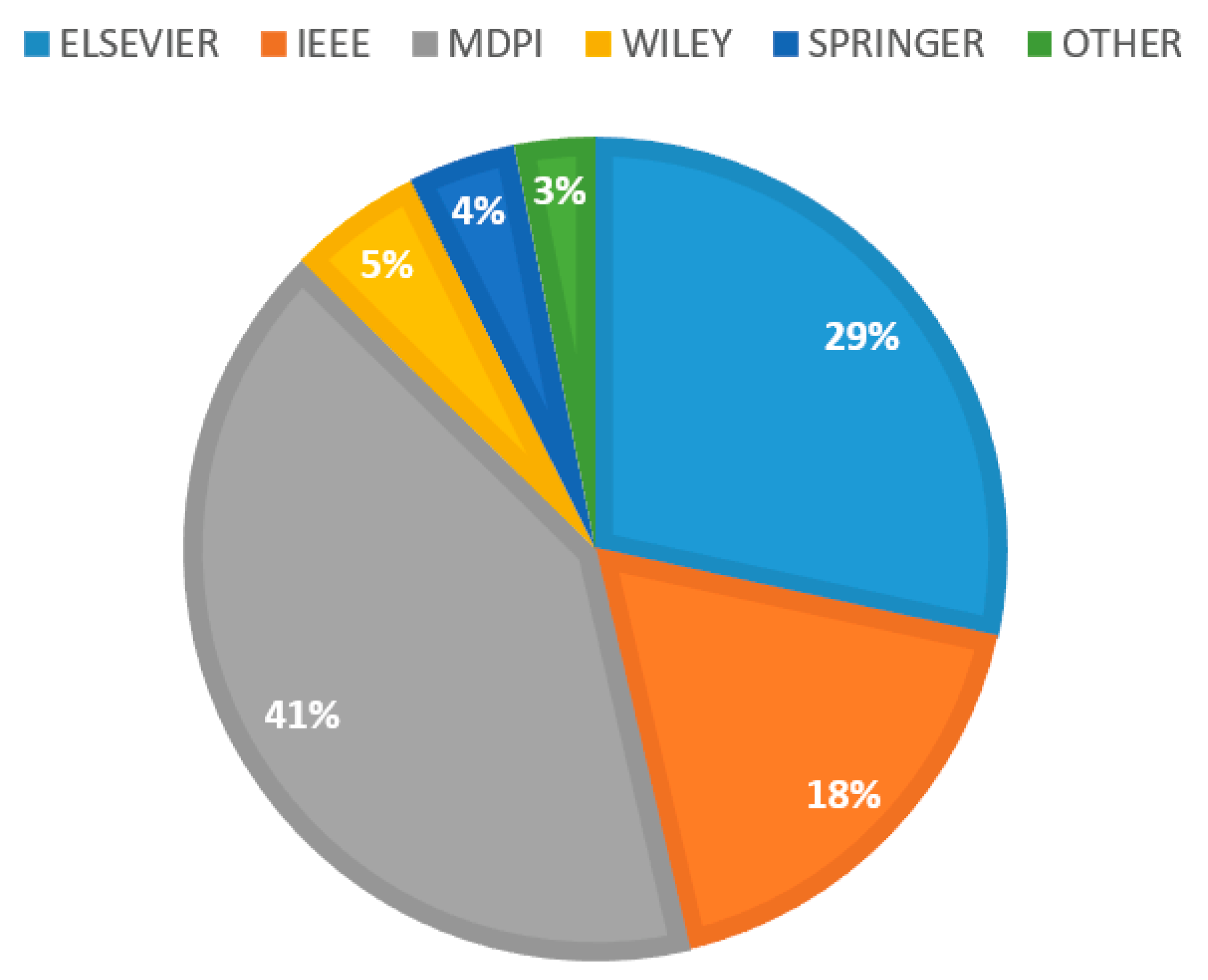
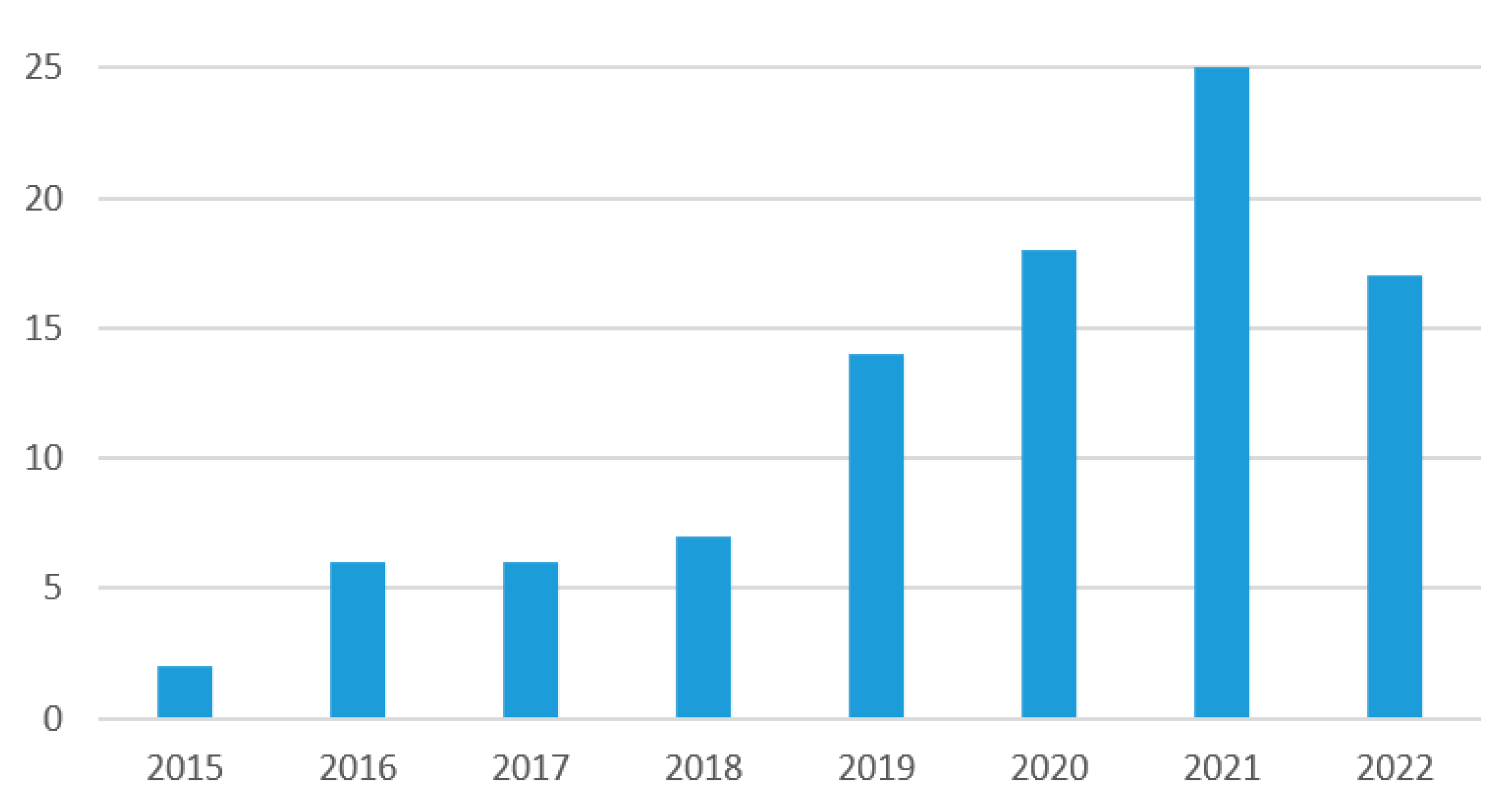
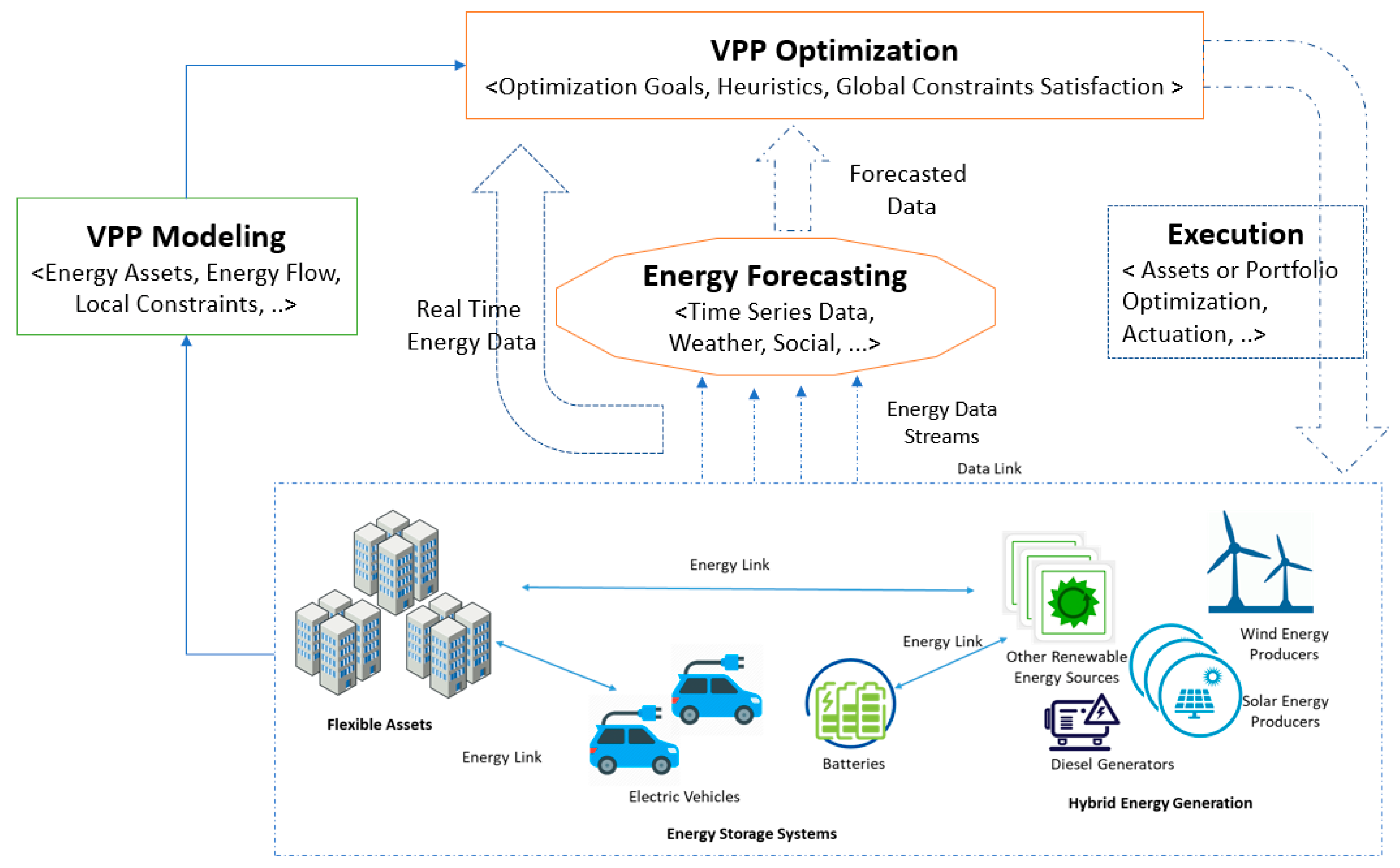
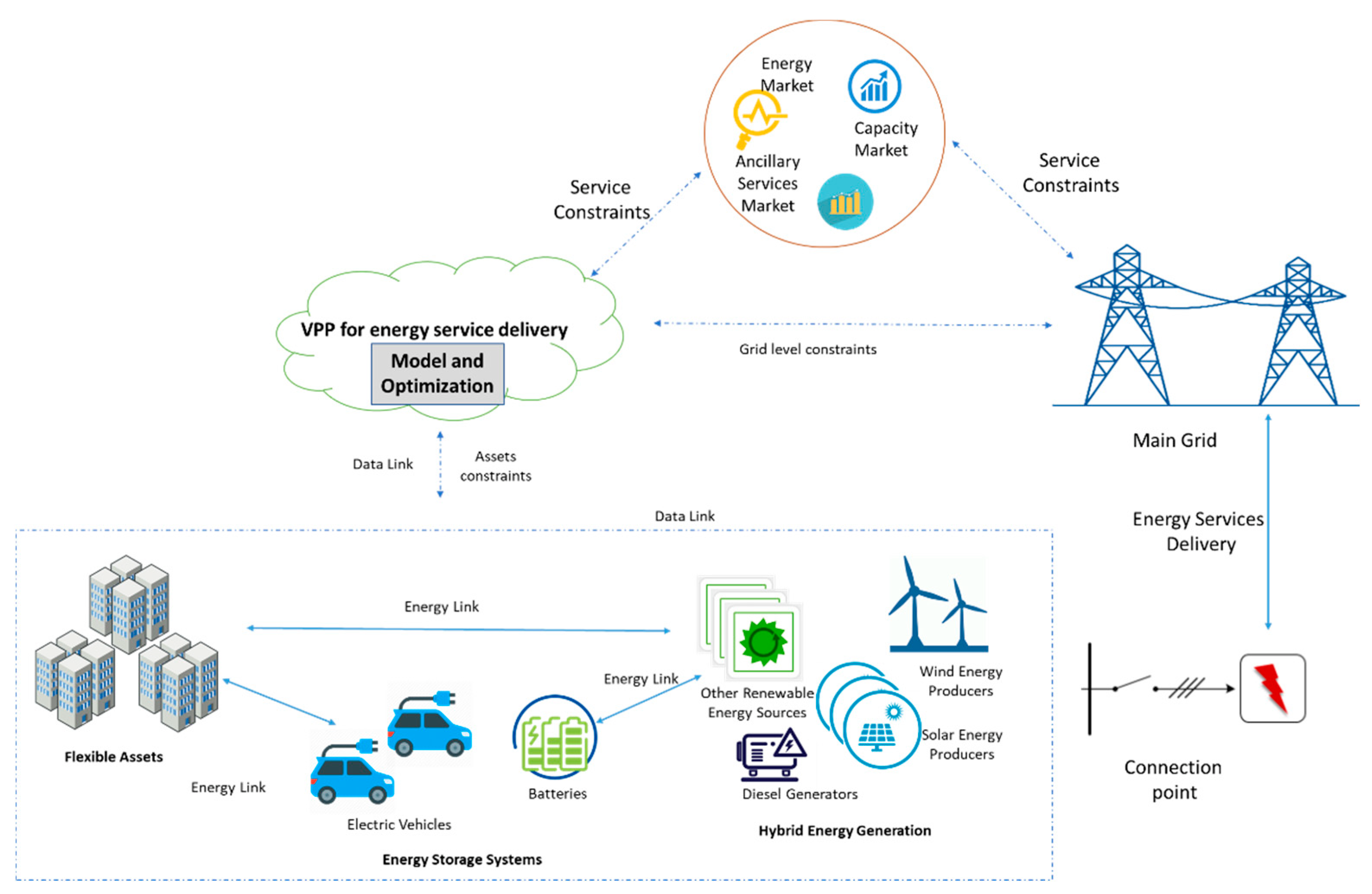
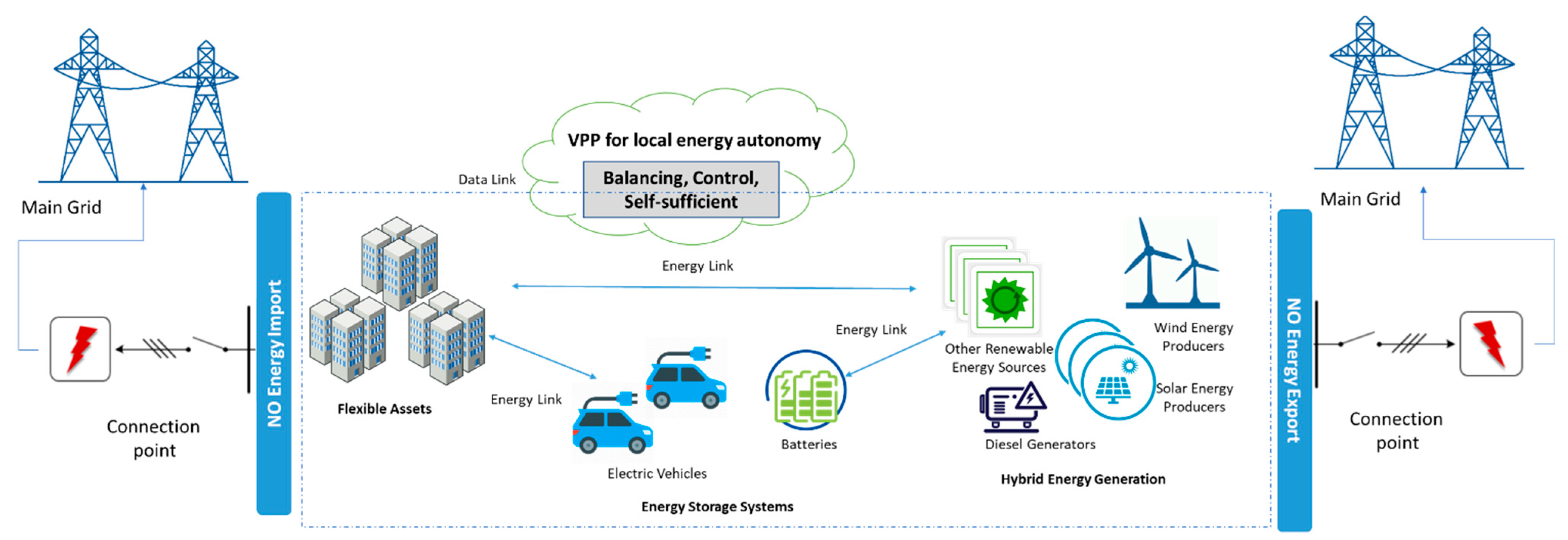

| Inclusion Criteria | Exclusion Criteria |
|---|---|
| MDPI, IEEE, Elsevier, or other highly rated databases | Not available as full text |
| Conference proceedings | Low number of citations/views |
| Journal articles/review papers | Not connected to the research topic (VPP applications for smart grid) |
| Usage of English language | Duplicate |
| Publication date 2015+ |
| VPP Research Direction | No. Approaches | References | |
|---|---|---|---|
| VPP concepts and technology | Digital twins of energy assets | 13 | [9,10,11,12,13,14,15,16,17,18,19,20,21] |
| Energy forecasting | 14 | [1,22,23,24,25,26,27,28,29,30,31,32,33,34] | |
| Optimization and coordination | 18 | [35,36,37,38,39,40,41,42,43,44,45,46,47,48,49,50,51,52] | |
| VPP applications in smart grids | Energy services delivery | 31 | [4,5,22,35,38,53,54,55,56,57,58,59,60,61,62,63,64,65,66,67,68,69,70,71,72,73,74,75,76,77,78] |
| Local energy autonomy | 21 | [5,36,44,75,78,79,80,81,82,83,84,85,86,87,88,89,90,91,92,93,94] | |
| Energy communities’ sustainability | 18 | [51,52,63,64,93,95,96,97,98,99,100,101,102,103,104,105,106,107,108] | |
| VPP Energy Service | Literature Approach |
|---|---|
| Imbalance prevention, store for excess power, peak-cut | [58,62,66,67,73,76,77,78] |
| Load scheduling and balancing, | [54,55,57,58,68,69] |
| energy trading | [35,38,53,54,56,57,58,59,60,61,65,68,70,74,75] |
| Energy consumption/production prediction | [5,55,57,60,61,63,64,69,77] |
| Energy backup and stability | [22,61,71,72,74,75] |
| Capacity management, frequency regulation | [4,54,58,62,73,74,78] |
Publisher’s Note: MDPI stays neutral with regard to jurisdictional claims in published maps and institutional affiliations. |
© 2022 by the authors. Licensee MDPI, Basel, Switzerland. This article is an open access article distributed under the terms and conditions of the Creative Commons Attribution (CC BY) license (https://creativecommons.org/licenses/by/4.0/).
Share and Cite
Goia, B.; Cioara, T.; Anghel, I. Virtual Power Plant Optimization in Smart Grids: A Narrative Review. Future Internet 2022, 14, 128. https://doi.org/10.3390/fi14050128
Goia B, Cioara T, Anghel I. Virtual Power Plant Optimization in Smart Grids: A Narrative Review. Future Internet. 2022; 14(5):128. https://doi.org/10.3390/fi14050128
Chicago/Turabian StyleGoia, Bianca, Tudor Cioara, and Ionut Anghel. 2022. "Virtual Power Plant Optimization in Smart Grids: A Narrative Review" Future Internet 14, no. 5: 128. https://doi.org/10.3390/fi14050128
APA StyleGoia, B., Cioara, T., & Anghel, I. (2022). Virtual Power Plant Optimization in Smart Grids: A Narrative Review. Future Internet, 14(5), 128. https://doi.org/10.3390/fi14050128








